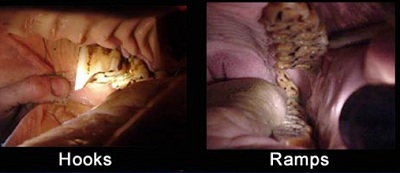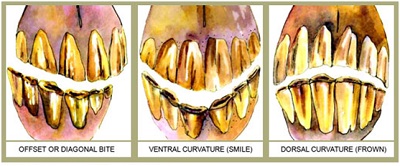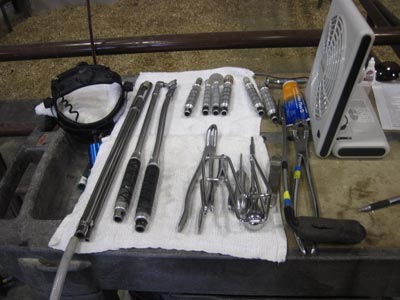Information about Equine Dentistry
Why equine dentistry is important
In the wild horses eat coarse shrubs and grass with a high silica content in it, in order to grind these substances horses need to have a large amount of lateral excursion (the side to side movement) in order to create a large enough force to breakdown the food material. This means that a larger amount of the tooths surface is in wear during mastication (chewing) preventing too many sharp points from forming on the buccal (cheek side) of the upper teeth and lingual (tongue side) of the lower teeth.
Wild horses also eat from the ground, when the horse lowers its head its mandible (lower jaw) drops and therefore shifts the lower cheek teeth further forward. This allows the first upper tooth and the last lower tooth to be worn thoroughly during mastication (chewing). As the horse raises its head, to look around, the mandible is shifted back again allowing the whole of the cheek teeth arcades to be worn evenly.

With our domesticated horses today, they are feed soft industrialised feeds and haylage which requires less force to break it down, this means that less lateral excursion (side to side movement) is needed. This leads to the formation of sharp points on the buccal (cheek side) of the upper teeth and lingual (tongue side) of the lower teeth. Today horses are also fed from haynets or raised haybars, and fed there feed from raised mangers. This prevents the mandible from shifting forward during mastication (chewing) therefore not allowing the whole of the cheek tooth arcade to be in wear. This will lead to the development of hooks on the first upper cheek tooth and ramps on the last lower cheek tooth. This leads to a shift back of the mandible (lower jaw) and prevent the mandible from being able to shift forward when the head is lowered. The ridden horse would feel tight when working on the bit, ether leaning on or snatching at the reins.


Exaggerated transverse ridging (ETR) is another common dental problem in the domesticated horse. Transverse ridging across the surface of the tooth is normal and is the result of equine teeth being made up of three differing substances enamel, dentine and cementum They wear at differing speeds with enamel being the hardest substance and cementum being the softest. These ridges form as the cementum is worn away leaving the harder enamel ridges on the surface of the tooth. If these become to exaggerated they prevent the horse from being able to slide its jaw rostral (forwards) and caudal (backwards). This is most commonly seen in young horses upto 10 years old but can be seen in all ages. If the horse feels tight and resists working in an outline or opens its mouth whist being ridden this may be the cause.

Young horses teeth are angled towards each other in an arcade as shown below this helps to keep the teeth tightly together, as horses age these teeth become straighter and abnormal gaps between teeth at the tooths surface can form known as diastema. These can be very painfull as food can get trapped in these gaps causing periodontal disease to start forming in the area. Overtime the periodontal disease will get worse if no treatment is given to the horse and could lead to the tooth becoming loose and having to be extracted.

Incisors also develop abnormal wear patterns, these can either be due to the conformation of the horses head such as a ventral curvature (smile) can be developed due to the horses maxilla (upper jaw) being longer then the lower jaw creating an overjet, overbite or parrot mouth. A dorsal curvature (frown) can be the result of the lower jaw being longer then the upper jaw creating an undejet, underbite or sow mouth. A wedge and diagonal bite can be the result of uneven chewing patterns of the horses cheek teeth either by only wanting to eat on one side due to oral discomfort or due to conformation of the cheek teeth and incisors or trauma.
Warning signs
If any of the signs below are seen in your horse they may be signs of oral discomfort and it is advised to get there teeth checked:
- Quidding (dropping food)
- Large particles of undigested feed in droppings
- Feed packing in the cheeks
- Foul odour from the mouth
- Unilateral nasal discharge (from one nostril)
- Loss of weight
- Head tilting, especially when ridden
- Head shaking or tossing
- Temporomandibular sensitivity on palpation
- Reluctance to accept a contact when being ridden
- Opening of mouth whilst being ridden
- Loss of performance
- Unable to move lower jaw sideways

Instrumentation
The majority of my work is carried out using battery powered equine specific instruments, although I still use hand floats occasionally. I have found that horses tolerate this type of instrumentation far more and it is more soft tissue friendly. These power tools allow for accurate equine dentistry as each tooth in the arcade can be reduced individually as needs be. The burrs used are diamond coated and reduces tooth effectively but do not cut the gum.
Geriatric horses really benefit from this type of instrumentation as their teeth are short and have less root to anchor them into their sockets, therefore hand floats risk loosening the teeth further during the pulling action, where as the power tools have no pull.

Follow equidentist on
 Tweet
Tweet

